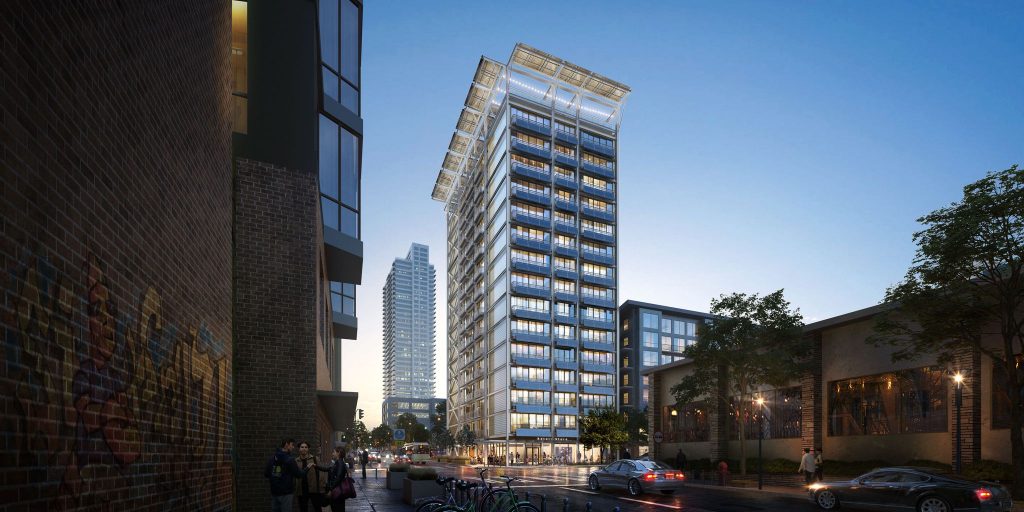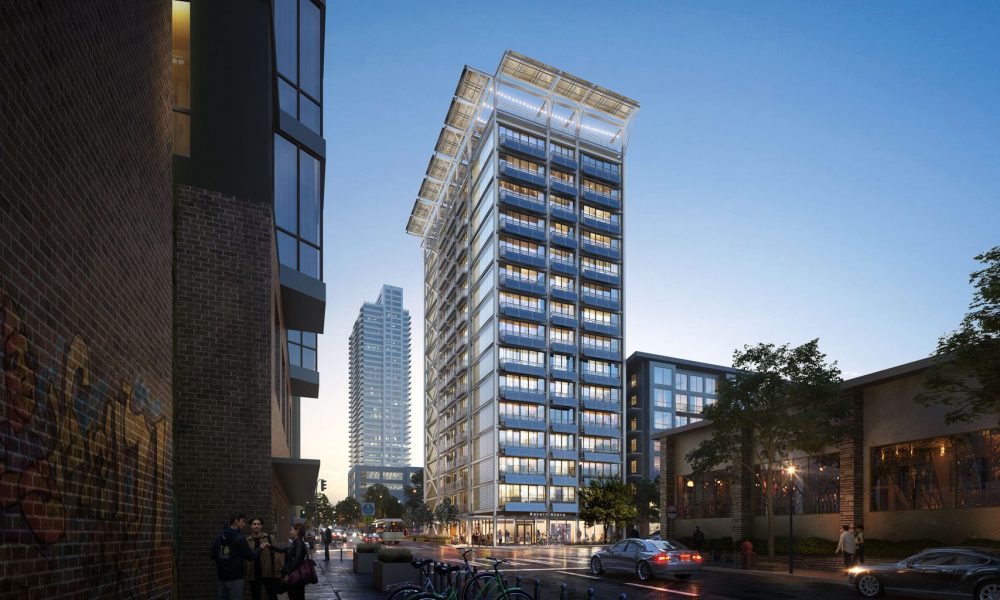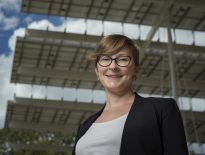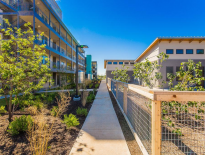The 303 Battery Street project is a new high-rise residential project in Seattle, Washington, developed by Sustainable Living Innovations (SLI). The project is located at the corner of Third Avenue and Battery Street in the Belltown neighborhood, directly northwest of downtown. This 15-story, includes 112 residential units and ground floor retail and is pursuing International Living Future Institute’s (ILFI) Living Building Challenge Petal Certification by targeting the Energy, Place, and Beauty Petals. This project is participating in the City of Seattle’s Living Building Pilot Program (LBPP), a local ordinance-based land use incentive program, to show their commitment to going above and beyond what sustainable construction looks like in Seattle.
In order to achieve Petal Certification, this project was tasked with fulfilling requirements that include incorporating urban agriculture, achieving a net-positive energy balance, and prioritizing tenant education and engagement with the building. The team has worked from early stages to prioritize the sustainability and positive impact of this project from both a social and environmental perspective.
The project broke ground in June 2021, and ILFI’s Energy + Carbon Manager Haley Gardner had the chance to talk with SLI’s Chief Technical Officer, Eric Hinckley, to learn more about the impact and progress of this innovative project!
Q: What were your sustainability goals for this project? Why did you choose to pursue Petal Certification with ILFI?
A: SLI set out to build one of the most technological and energy efficient high-rise apartment buildings in the world. ILFI sets the most rigorous standard for efficiency in the built world, thus the reason SLI chose to partner with ILFI on this exciting project.
Q: How do you expect your prefabricated construction process to go? Have there been any big hurdles to overcome using this innovative delivery method, and if so how have you addressed them?
A: Approximately 95% of the 303 Battery panels have been assembled and are in storage. This means that 95% of the building (above grade) is already built! Those panels will be shipped to site for erection starting September 2021. The biggest struggle has been the effects of the pandemic and Covid-19 related to labor, and the general slowdown of the world. Additionally, the global supply chain has thrown a wrench in our well-oiled machine. Supplies have been slow to get, causing panel assembly delays and ultimately onsite erection delays.
Q: What is the anticipated timeline for construction and how does this compare to a more typical timeframe?
A: We anticipate having the building completed by July of 2022, approximately 30% quicker than a typical, conventionally built high-rise apartment building. Once the podium is constructed, i.e. the conventionally built portion of the building process, SLI can then begin the panelized portion of the erection, which is where the speed of our process really takes off.
Q: How did you make sure that your sustainability goals stayed a top priority through every stage of the design and delivery process?
A: Every part of our design process starts with sustainability or resource elimination. One of our design mottos is: use the delete key! By that we mean, what can we remove from our design that does not add value, efficiency or is redundant? Additionally, we also seek to use all free space to maximize renewables, like mounting solar panels on our balconies, SE-facing vertical building wall, and a covered rooftop patio.
Q: What is something that did not go as expected during the design process that resulted in the team having to be a bit creative in their problem solving?
A: Designing and inventing a new building system takes time. Challenges arise often. We have a very robust design and engineering team along with a back office process that ensures success. Additionally, we leverage industry-leading technology solutions and tools like BIM in order to stay ahead of issues and roadblocks. Ultimately, internal coordination and communication is absolutely necessary to achieve the level of success we strive for.
Q: The building includes roof-top solar in addition to panels on two facades in order to maximize solar production in a dense urban setting, an approach that is creative to say the least. Why did you take this approach, and what have been the benefits and challenges to this approach from planning through construction?
A: We wanted to maximize all available space in order to maximize our solar panel count and thus produce as much energy as possible. For example, the products to support solar panels on a vertical wall on a building or to mount to a balcony do not exist. All facades containing solar panels are custom in-house design and built. We have had to go through long and lengthy engineering and testing in order to satisfy all code officials, in addition to making the building look as beautiful as possible. I am very proud of the end result. Certainly not an inexpensive endeavor, but one that adds another unique aspect to the building’s design and functionality.
Q: Achieving net zero energy involves a lot of work during design and construction, but nearly the same amount of coordination during operation. Typically, residents of high rise multifamily housing play a key role in the amount of energy used and can make or break a net zero project staying on track. What strategies are you planning on implementing during occupancy to ensure those energy targets are met?
A: We have developed our own in-house smart home technology and software solution to help customers track their daily, monthly and annual energy and water use. Additionally, we provide all tenants a view of anonymous data on how they compare to the other tenants in the building. Early testing has shown that folks are naturally competitive and will work towards maximizing their energy and water savings use in order to “be the best.” Lastly, our software contains an “artificial intelligence” or machine learning platform, which will assist building facilities managers in identifying and responding to abnormal energy and water usage patterns.
Q: You are pursuing the Energy Petal under the Living Building Challenge, along with Place and Beauty. Why did you choose to pursue the Place and Beauty Petals specifically? What benefits did the team experience when creating a more holistic design that goes beyond Zero Energy?
A: We wanted a well-rounded product. Energy is a notable petal, but Place and Beauty are just as important, especially as we think about a Living Building. Place and Beauty allow us to connect with the local environment, people and culture. A rooftop balcony covered in solar should be the standard for an Energy/ Place petal combination. It doesn’t get better than that!
Q: What advice would you give to other developers or owners of high rise or multifamily projects?
A: Go for it. Think different. Be different. Create something amazing! While the process is not easy, the outcomes are more than worth it! Through our design and engineering process, we have made many innovations that previously did not exist in the built world. Our journey to achieve an ILFI-certified building has led us down a path of innovation and invention. We now have a whole slew of products that have the capability to materially change any and all future apartment buildings for the better in the built world.



